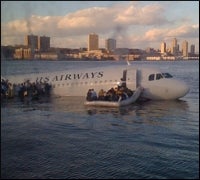 |
| Source: Janis Krums’ Twitter feed Click for full image on TwitPic. |
Yesterday’s dramatic emergency landing of US Airways Flight 1549 in New York’s Hudson River made national TV and newspaper headlines. But the story broke first across social networking sites and through mobile messages — giving social media a major coup that its fans are crowing about.
Photographs showing Flight 1549’s emergency landing began popping up on social networking sites like Facebook and microblogging services like Twitter and Tumblr well before national news reports caught wind of the story. And for Web users who were at work, out of the office, or otherwise far from a TV, social media remained their sole source for updates on the story.
One of the earliest crash photos popped up on Twitter and TwitPic, a site that hosts images that users post on Twitter. The photo had been taken by iPhone user Janis Krums. Within minutes, the image was appearing on blogs and news sites — causing TwitPic’s site to get slammed by traffic, according to a posting by its founder and operator, Noah Everett.
A half-hour later, Krums’ eyewitness photo had led him to be interviewed by MSNBC for a live report on the event. Many other television and print news outlets, including ABC’s “Good Morning America,” relied in their stories on Krums’ photograph or others that had been posted on social networking sites.
Not surprisingly, the impact of reports like Krums’ wasn’t lost on Twitters’ users.
“That is the power of social media. News spreads so fast,” wrote Twitter user Jason Tryfon. Fellow Twitter user “Peepee” claimed “Twitter is faster than CNN.”
“So, news of the plane crash in the Hudson broke following a photo posted on twitpic? Pretty remarkable,” wrote Twitter user “neilallison.”
“The Hudson River plane crash is my first experience where Twitter ‘broke the story’ for me,” added another Twitter user, “irusty”.
As of this morning, there were more than 1,500 posts on Twitter about the Hudson plane crash, ranging from initial reports to next-day self-congratulatory assessments about how social networking provided information faster than any other medium.
Yet other observers of the phenomenon were quick to downplay the significance.
“I’m sure people will say Twitter provided all the news on Hudson River crash, but I found little info there while TV was loaded,” wrote online media vet Neil Budde, founding editor and publisher of The Wall Street Journal Online and now president of news aggregation site DailyMe.com.
Others were of a similar mindset.
“To those [that think] soc med (twitter) has killed trad. media: Twitter can’t write this piece on crash [survivors],” wrote John Sternal, a public relations consultant, pointing to a local news story about one of the plane’s lucky passengers.
Media outlets aren’t the only ones struggling to understand and leverage the growth of social media. Businesses and community organizations, such as the Red Cross, are embracing the technologies as well. Red Cross officials have stated Twitter has proved to be the most successful tool in disaster response scenarios, such as the recent wildfires in California.
The instantaneous reporting aspect, and immediate self correcting ability, are key elements, said the Red Cross, which has over 3,000 subscribers to its Twitter feed.
There’s a potentially ominous side to the trend as well. While social networking sites afford real-time news sharing and reporting, critics have been vocal about drawbacks such as erroneous reporting and misuse for political and military purposes.
One recent report in the 304th Military Intelligence Battalion periodic newsletter tracked noted that new terrorist tactics are also seeing the value of Twitter and other social networking sites for their causes.


